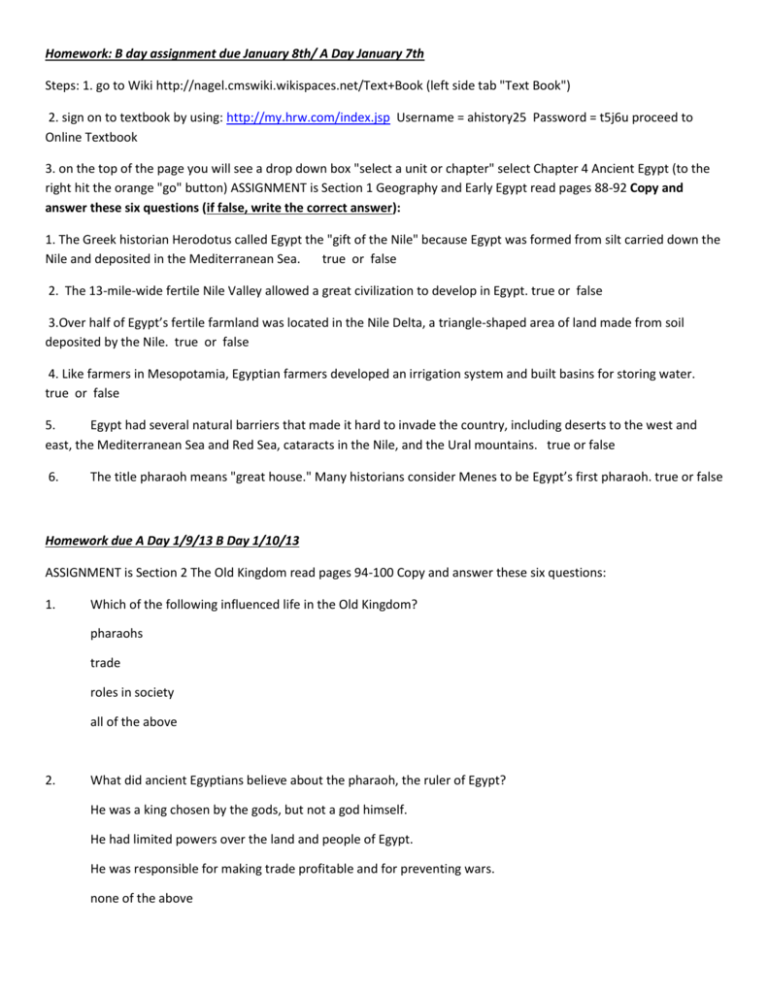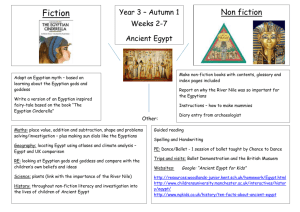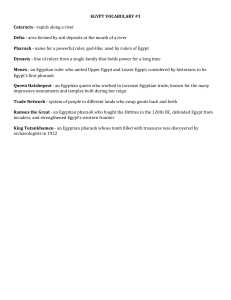EgyptHomework
advertisement

Homework: B day assignment due January 8th/ A Day January 7th Steps: 1. go to Wiki http://nagel.cmswiki.wikispaces.net/Text+Book (left side tab "Text Book") 2. sign on to textbook by using: http://my.hrw.com/index.jsp Username = ahistory25 Password = t5j6u proceed to Online Textbook 3. on the top of the page you will see a drop down box "select a unit or chapter" select Chapter 4 Ancient Egypt (to the right hit the orange "go" button) ASSIGNMENT is Section 1 Geography and Early Egypt read pages 88-92 Copy and answer these six questions (if false, write the correct answer): 1. The Greek historian Herodotus called Egypt the "gift of the Nile" because Egypt was formed from silt carried down the Nile and deposited in the Mediterranean Sea. true or false 2. The 13-mile-wide fertile Nile Valley allowed a great civilization to develop in Egypt. true or false 3.Over half of Egypt’s fertile farmland was located in the Nile Delta, a triangle-shaped area of land made from soil deposited by the Nile. true or false 4. Like farmers in Mesopotamia, Egyptian farmers developed an irrigation system and built basins for storing water. true or false 5. Egypt had several natural barriers that made it hard to invade the country, including deserts to the west and east, the Mediterranean Sea and Red Sea, cataracts in the Nile, and the Ural mountains. true or false 6. The title pharaoh means "great house." Many historians consider Menes to be Egypt’s first pharaoh. true or false Homework due A Day 1/9/13 B Day 1/10/13 ASSIGNMENT is Section 2 The Old Kingdom read pages 94-100 Copy and answer these six questions: 1. Which of the following influenced life in the Old Kingdom? pharaohs trade roles in society all of the above 2. What did ancient Egyptians believe about the pharaoh, the ruler of Egypt? He was a king chosen by the gods, but not a god himself. He had limited powers over the land and people of Egypt. He was responsible for making trade profitable and for preventing wars. none of the above 3. Who made up more than 80 percent of Egypt’s population? slaves farmers servants government officials 4. Which of the following was NOT a major Egyptian god? Re, the sun god Isis, the goddess of magic Anubis, the god of the dead Ganesh, the sky god 5. What did the Egyptians believe about the afterlife? It was similar to the real world. It was a place where one’s ka lived after death. It was a frightening place filled with souls waiting to be reborn. none of the above 6. In ancient Egypt, who was entombed in pyramids? gods nobles pharaohs priests Homework A Day due 1/15/13 B Day 1/14/13 ASSIGNMENT is Section 3 The Middle and New Kingdoms and Section 4 Egyptian Achievements read pages 101-113 Copy and answer these fourteen questions: Section 3: The Middle and New Kingdoms 1. The period of order and stability that lasted from 2050 BC until about 1750 BC was called the? ._________________________________ 2. Although it did not last, the _________________ was the period during which Egypt reached the peak of its military might, power and glory, and trade successes. 3. In order to increase trade,________________ sent Egyptian traders south to trade with people along the Red Sea and north to trade with people in Asia Minor and Greece. 4. _____________________________ were well-respected members of the Egyptian middle class who worked for the government and the temples; they kept records and accounts and copied religious and literary texts. 5. _______________________________ were able to climb the social ladder in Egypt by gaining land as payment; they could also keep any treasure they captured in war. 6. Egyptian women had a number of ________________________ ; for example, they could own property, make contracts, and divorce their husbands. Section 4: Egyptian Achievements Directions: Use the word bank below that best answers the question. 1. one of the world’s first writing systems _______________________________ 2. made lasting achievements in writing, architecture, and art ___________________________________ 3. long-lasting, paper-like material made from reeds that was easy to roll into ________________________________ 4. key that allows historians to read ancient Egyptian writing ____________________________________________ 5. work of literature about the afterlife that survived thanks to Egypt’s dry climate __________________________ 6. imaginary creature with the body of a lion and the head of another animal or a human _____________________ 7. lavishly decorated temple built to honor Amon-Re, the sun god _______________________________________ 8. boy pharaoh whose undisturbed tomb has taught historians much about Egyptian burial practices and beliefs _____________________________________________ WORD BANK. King Tutankhamen hieroglyphics Egyptians Rosetta Stone papyrus sphinx The Book of the Dead Temple of Karnak









